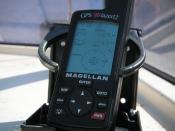Historical Background
Huffman Trucking has a long-standing record of providing exemplary service for a reasonable price. K. Huffman founded Huffman Trucking in 1936 in Cleveland, Ohio using a single-tractor trailer to haul goods from the open plains of Ohio's farm fields to the big city. The company had a dramatic growth spurt because of the Second World War when there was an increased demand for the transportation of manufactured goods from the factories of the Midwest to ports along the East coast. By 1945, relationships with government services allowed Huffman Trucking to grow to 16 tractors, and 36 trailers. Huffman Trucking continued to grow with the acquisition and takeover of five major trucking firms in the eastern-half of the United States. Today, Huffman Trucking delivers coast-to-coast and in Canada with major hubs in Cleveland, Los Angeles, St. Louis, and Bayonne. With 800 tractors and over 2,100 trailers, Huffman Trucking is a major player in the United States shipping arena.
What makes Huffman Trucking a cut above the rest? Huffman Trucking was the first trucking operation to introduce new technologies to make trucking easier to manage, safer and more convenient for driving and cost-effective for the company.
Introducing the GPS
The Global Positioning System (GPS) is invaluable to any trucking business. Owners can keep track of where his or her trucks are at any given time. If the driver gets lost, the GPS can tell them where they are and how to get where they need to go. The GPS can also be used as an intercom to allow truck drivers to communicate with home base whenever the need arises. The GPS can note the location of low bridges or construction, allowing the driver to take an alternate route. Financially, trucking cannot afford to be without it GPS technology.
The trucking industry has become very complicated. High fuel prices and employee turnover rates are the highest in history. Frustration levels are high among owners and drivers alike, (the primary stakeholders) due to the necessity of increasing prices to carry loads and lower wages for the drivers to compensate for higher fuel prices. Work has become more stressful for drivers (cases have occurred where drivers have simply left loaded trucks in parking lots and walked away, not bothering to contact the owner to let them know that they quit or where their trucks are located). Trucking companies lose thousands of dollars in lost trucks, extra fuel, and loss of loads to spoilage or late fees (Car Nav, 2006).
Truck drivers in Canada are also experiencing the same problems American drivers are experiencing. They have difficulty communicating with home base and difficulty getting lost in areas they are not familiar. They cannot get directions from the home base because their cell phones are out of service, out of area, or the battery has died. They travel into the United States and get lost in unfamiliar surroundings. This produces a high turnover rate for truck drivers, mostly due to frustration. The cost of fuel is higher because of waste in trying to find their locations and correct directions. They are also leaving their loads, causing the company losses in money, late fees, and damaged (the reefer units in refrigerated trailers runs out of gas and the contents of the load is spoiled). That could result in a loss of thousands of dollars.
The introduction to a new form of technology into the workplace environment can at times be very stressful. Some feel that there is too much technology and that it is taking over the world. When introducing a new form of technology to the company the owners and managers of the company need to make sure that in addition to benefiting the company as a whole, that the technology also benefits the individual worker as well. The new technology must not make the worker feel that his or her job is being taken over by machines or that the technology is going to allow "big brother" to watch over them more closely. A good example of this occurred when the major automobile manufacturers started to introduce robotic machines to handle some of the production of parts for cars and trucks. This caused a dramatic shift in the attitudes employees. Some employees left in anger because, machines replaced their jobs and others changed to different types of jobs that more or less assisted the robots in the manufacturing of parts and automobiles. A similar occurrence happened when Computer Aided Drafting or CAD was introduced. This computer program eliminated the need for the giant pad and paper in which to draw plans for the manufacturing of just about anything. Today, this technology is used in the development of military hardware, cars, boats and even homes and buildings. While the introduction of the GPS systems will allow numerous benefits to the owners of the company, it will also improve the working environment for the drivers themselves. The owners need to stress the benefits of the GPS system to the drivers when announcing the implementation of the GPS systems in the trucks rather the benefits to the company. Some of the benefits that should be stressed to the drivers are the ability to get up-to-date construction information, directions to any place in the United States or Canada as well as the ability to communicate with family and friends while the driver is on the road.
While the other features are important to the company and are worth mentioning, they should not be stressed. This function of the system that should not be stressed is the company's ability to monitor location, speed, idle times, engine temperatures, and well as freight temperatures. All these systems will make sure that the driver is on track and not breaking any laws to ensure that the shipment arrives safely and on time. Making the drivers feel comfortable using the system is going to require a substantial amount of training, and practice. The more the drivers use the system the more they will realize the benefits and the ease of use.
Many truck drivers take the jobs because they want to ride the open roads of the country and be a free spirit. There are some GPS systems available that the home base can tell how fast the truck is going, how long the truck has been running, how long the driver stopped, engine temperature, and trailer temperature (Advanced Tracking Technology, 2005). Some truck drivers feel that having a GPS on the truck is a lifesaver due to being able to get directions around construction, and being able to get help if something happens. Some trucks are installing panic buttons that can signal a highjacking and alert police of the situation. The police are then able to track the truck using the GPS and recover the vehicle. Trucking, like any other business, is a business. The success of business greatly depends on its employees. There is a saying that "the business is only as strong as its weakest employee." This statement is true. All employees should work towards the goals set by the organization and managers need to make sure that the employees are staying on track. The operations of an organization need to be done correctly and efficiently in order for the organization to be successful. Managers need to recognize those employees that are doing well and correct those who are not. In trucking, it is not always easy to monitor the employees. GPS tracking gives management that ability (Impact Lab, 2004).
Ethical Considerations
There is always an ethical view to introducing something new to a company. Implementing new systems into a company means that there will be changes taking place. The change will inevitably cause people to think about the affect it will have on other aspects of the business. The GPS system will also cause ethical considerations. Privacy is a huge issue in the world now. There are privacy laws to protect everything you can think of because unfortunately, we live in a society where someone always has to cross the line. The GPS system is unique because it tracts the whereabouts of any given truck at any time it is on the road. The complaint has been expressed that t compromises the privacy of the driver. The drivers might end up feeling as if they are being watched or monitored while they work. They would feel like their employer lacks trust in their ability. The more experienced drivers would resent the help and would feel like they can get where they need to be on their own, after all, they have been doing it for years. The owners on the other hand, feel like the drivers should have nothing to hide and the GPS can only help motivate the driver to work harder and to take care of the truck. The GPS also monitors the speed of the truck. In the past, the owners have had issues with drivers pushing the trucks too hard and causing more frequent breakdowns resulting in costing the company more money in repairs. Both sides of the story are understandable.
It is very important to have a meeting with the employees to introduce and explain the GPS system and its benefits. The company needs to reassure the employees that they are trusted and that their privacy is important. The GPS system will only save the company money and eventually that will show in the employees' paychecks. There is always some resistance to change. Some may be accepting while others may resist. The company needs to be willing to hear complaints from the employees, especially in the first few months of operation. The proof will be in the way that all stakeholders work together to make the GPS system implementation a success for everyone.
Conclusion
The possibilities of GPS truck monitoring are endless. Huffman trucking is committed to providing the best products to ensure the safe delivery of cargo to clients. There has been an increasing problem when it comes to GPS tracking. The tracking software only covers the United State or Canada. Huffman tracking has developed a software package that incorporates both countries for a lower price than some companies are charging for one country. Another problem that truckers face while on the road is not having updated construction information. At Huffman trucking, our HuffTrack XNA software can also be tied in with Internet connection to download the most current construction information from the Department of Transportation in the United States and Transport Canada (Virtual Organization, University of Phoenix). This will allow truckers to stay on schedule. The benefits are endless for the trucking company as well. Home base will not only be able to see where their trucks are, but be able to communicate with them, and monitor several truck functions (such as speed, idle time, and temperature of the cargo). The company can also be alerted if the driver is away from the truck for long periods. The possibilities are endless.
References
Advanced Tracking Technologies, Inc., 2005. Retrieved July16, 2006 from:
http://www.advantrack.com/sw_vehicle_tracking_overview.htm.
Car Nav Systems. Retrieved July 16, 2006 from:
http://www.carnav.com/index_aboutus.html
Impact Lab, (2004). Bosses Keep Mobile Workers on Short Leash. Retrieved July
16, 2006 from:
http://www.impactlab.com/modules.php?name=News&file=article&sid=4591
University of Phoenix, Virtual Organizations,
https://ecampus.phoenix.edu/ secure/aapd/CIST/VOP/Business/PortBus.htm


